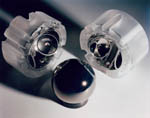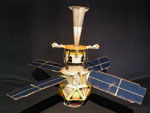WEEKLY HIGHLIGHTS FOR 9 JULY 2004:
GRAVITY PROBE B MISSION UPDATE

After 80 days in orbit, the spacecraft remains in excellent health, and all subsystems are continuing to perform well. All four gyros are digitally suspended and are currently spinning at approximately 3 Hz (180 rpm). Two weeks ago, the on-board computer was re-booted with a new version of the drag-free thruster-control software to work around two problematic micro thrusters that were isolated and taken out of service shortly after launch. The new software optimizes the performance of the Attitude and Translation Control system (ATC) using 14, instead of 16 micro thrusters, and it has been performing as expected since the re-boot. The spacecraft is flying drag-free around gyro #1, at a roll rate of 0.52 rpm, with the science telescope locked onto the guide star, IM Pegasi. We are now entering the home stretch of the Initialization and Orbit Checkout (IOC) phase of the mission.
- On Saturday, July 3rd, we re-locked the science telescope on the guide
star, IM Pegasi, with the spacecraft rolling at 0.5 rpm. The spacecraft remained
locked on the guide star throughout the 4th of July weekend.
- This past week, we continued testing and optimizing ATC performance in both primary and backup drag-free modes. Based on this testing, we have selected back-up drag-free as the nominal mode for the science phase of the mission. In back-up drag-free mode, the Gyro Suspension System (GSS) applies very light forces on the gyro to keep it suspended and centered in its housing. The ATC uses feedback from the GSS to “steer” the spacecraft so that the GSS forces are nullified or canceled, thereby keeping the gyro centered. Applying forces with the GSS to suspend the drag-free gyro adds a very small amount of noise to the gyro signal, but this noise is negligible, and it is outweighed by the added stability that has been demonstrated in our tests over the past few weeks. This increased stability is due to the fact that the back-up mode uses both the micro thrusters and the GSS to counteract drag on the spacecraft, whereas the primary mode relies solely on the micro thrusters to create a drag-free orbit.

- Yesterday, the roll rate of the spacecraft was slightly increased from
0.50 to 0.52 rpm, in preparation for the transition into the science phase
of the mission. This slightly higher roll rate was chosen based on ATC and
SQUID readout performance, as well as the requirement that the science phase
roll rate should not be a harmonic of either orbit or calibration frequencies.
We are in the process of evaluating whether or not further mass trim operations
will be needed for the science phase of the mission.
- On Friday, July 2nd, we successfully spun-up gyros #1 and #3 to 3 Hz (180 rpm), by streaming ultra-pure helium gas through their spin-up channels for 90 seconds each. This past Tuesday and Wednesday, July 6th and 7th, we followed suit with gyros # 2 and #4. Note that we cannot control the exact spin rate of the gyro rotors (spheres). Rather, we control the length of time that ultra-pure helium gas flows through the spin-up channel for each gyro, and then the SQUID readouts tell us the resulting spin rates—which may differ slightly from one gyro to another. Pending a final review meeting this afternoon, tomorrow morning, we are planning to stream helium gas over the gyro #4 rotor for another 90 seconds, thereby increasing its spin rate to approximately 6 Hz (360 rpm). Then, after performing a number of tests to ensure that gyro #4 and its suspension system are functioning properly, tomorrow afternoon, we plan to spin up this gyro to full speed by streaming ultra-pure helium over its rotor for approximately 90 minutes. We anticipate that the final spin rate of the gyro #4 rotor will be between 120 Hz (7,200 rpm) and 170 Hz (10,200 rpm). We will then monitor the performance of gyro #4 for several days before spinning up the remaining gyros to full speed.

Images & Photos: The diagrams of the GP-B experiment and the gyro rotor and housings are from the GP-B Image Archive here at Stanford University. The photo, showing the GP-B gyroscope rotor (sphere) and housings, was taken by photographer Don Harlan. The photos of the paper model of the GP-B spacecraft and the pre-launch press conference were taken by GP-B Public Affairs Coordinator Bob Kahn. Click on the thumbnails to view enlarged copies of these images.
More links on recent topics
- Track the satellite in the sky
- Photo, video & and news links
- Following the mission online
- Our mailing list - receive the weekly highlights via email
- The GP-B Launch Companion in Adobe Acrobat PDF format. Please note: this file is 1.6 MB, so it may take awhile to download if you have a slow Internet connection.
BUILD A PAPER MODEL OF THE GP-B SPACECRAFT
 New since July 5th, we have created a 1/20 scale, paper model of the
GP-B spacecraft that you can download as a PDF file, print out, and assemble.
There are two versions of the PDF file—a 6
MB high-quality version and a 2
MB standard-quality version. Both PDF files are compatible with Adobe
Acrobat 4.0 and later. The only visible difference between the versions
is that the colors are not
as bright
and
saturated
in the standard-quality
version,
but it will download in less time for people with low-speed Internet
connections.
New since July 5th, we have created a 1/20 scale, paper model of the
GP-B spacecraft that you can download as a PDF file, print out, and assemble.
There are two versions of the PDF file—a 6
MB high-quality version and a 2
MB standard-quality version. Both PDF files are compatible with Adobe
Acrobat 4.0 and later. The only visible difference between the versions
is that the colors are not
as bright
and
saturated
in the standard-quality
version,
but it will download in less time for people with low-speed Internet
connections.
Both versions include two pages of instructions and six pages of images to cut out and assemble. You’ll need scissors, an Exacto knife, a straight edge, glue (glue sticks and hot glue guns work well), Scotch tape, two 9.5” long, 1/8” diameter wooden dowels (shish-kabob skewers work well) about 3-5 hours, and patience to assemble the model. For best results, print the cut-out pages of the model on heavyweight paper. Glossy photo paper is a bit hard to work with, but it yields a very realistic-looking model.
Previous Highlight
Index of Highlights
